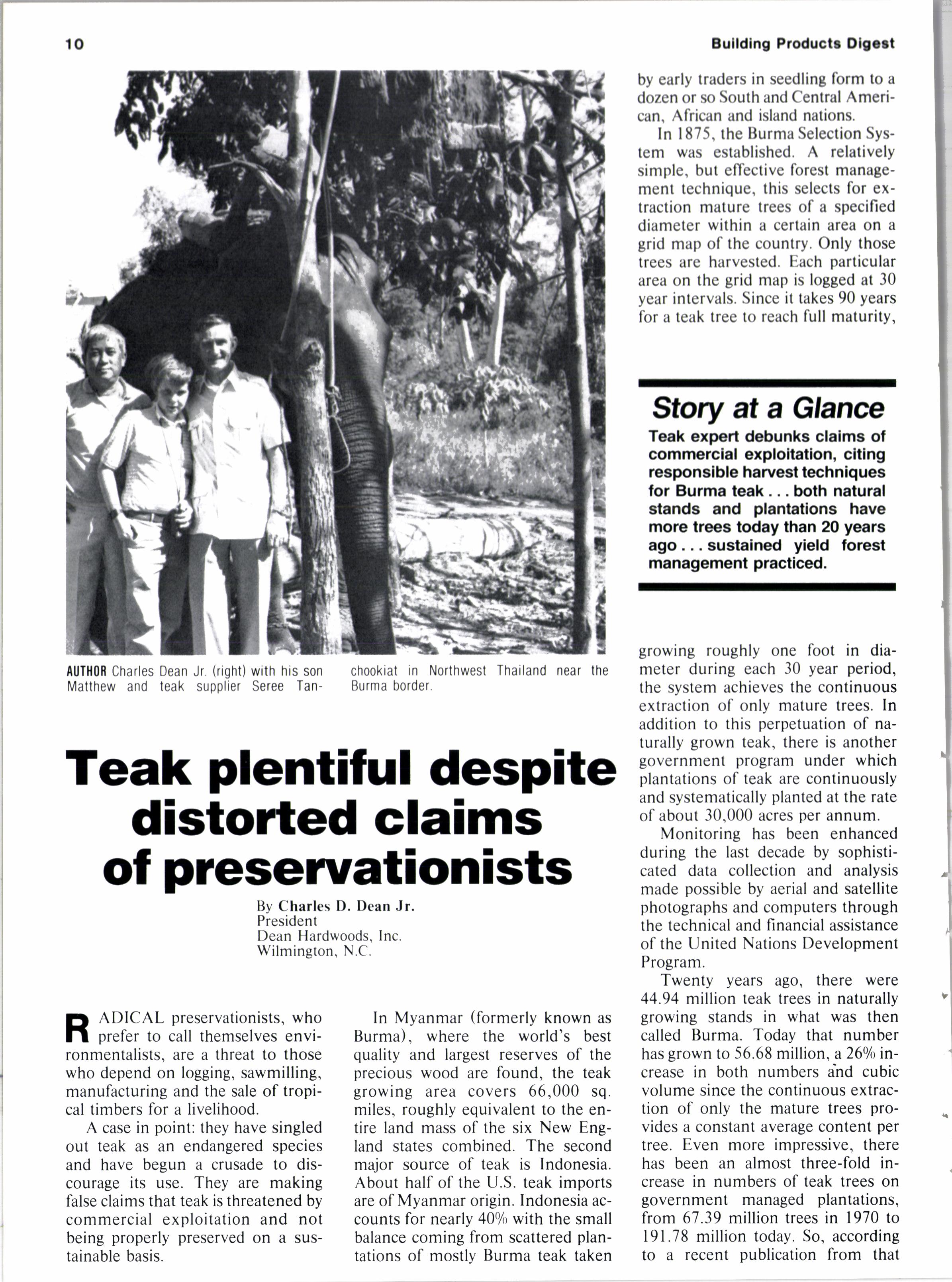
4 minute read
Teak plentiful despite distorted claims of preservationists
By Charles D. Dean Jr. President Dean Hardwoods, Inc. Wilmington, N.C.
;1 ADICAL preservationists, who
Jl prefer to call themselves environmentalists, are a threat to those who depend on logging, sawmilling, manufacturing and the sale of tropical timbers for a livelihood.
A case in point: they have singled out teak as an endangered species and have begun a crusade to discourage its use. They are making false claims that teak is threatened by commercial exploitation and not being properly preserved on a sustainable basis.
In Myanmar (formerly known as Burma), where the world's best quality and largest reserves of the precious wood are found, the teak growing area covers 66,000 sq. miles, roughly equivalent to the entire land mass of the six New England states combined. The second major source of teak is lndonesia. About half of the U.S. teak imports are of Myanmar origin. Indonesia accounts for nearly 400/o with the small balance coming from scattered plantations of mostly Burma teak taken by early traders in seedling form to a dozen or so South and Central American, African and island nations.
In 1875, the Burma Selection Syslem was established. A relatively simple, but effective forest management technique, this selects for extraction mature trees of a specified diameter within a certain area on a grid map of the country. Only those trees are harvested. Each particular area on the grid map is logged at 30 year intervals. Since it takes 90 years for a teak tree to reach full maturity,
Story at a Glane
Teak expert debunks clalms of commerclal exploltatlon, cltlng responslble harvest technlques for Burma teak. both natural stands and plantations have more trees today than 20 years ago. sustalned yield forest management practiced.
growing roughly one foot in diameter during each 30 year period, the system achieves the continuous extraction of only mature trees. In addition to this perpetuation of naturally grown teak, there is another government program under which plantations of teak are continuously and systematically planted at the rate of about 30,000 acres per annum.
Monitoring has been enhanced during the last decade by sophisticated data collection and analysis made possible by aerial and satellite photographs and computers through the technical and financial assistance of the United Nations Development Program.
Twenty years ago, there were 44.94 million teak trees in naturally growing stands in what was then called Burma. Today that number has grown to 56.68 million, a260/o increase in both numbers and cubic volume since the continuous extraction of only the mature trees provides a constant average content per tree. Even more impressive, there has been an almost three-fold increase in numbers of teak trees on government managed plantations, from 67.39 million trees in 1970 to 191.78 million today. So, according to a recent publication from that country, "The 130 year technical experiences of the Forest Department indicate that no environmental impacts will be felt and Burma's [sic] forests will be managed forever."
Turning to Indonesia, plantations of teak seedlings were planted more than a century ago during Dutch colonization. As the mature trees in these plantations have been harvested in recent years, new seedlings have been planted, in keeping with the policies of sustained yield forest management. This policy of harvesting no more timber than is being replenished with new growth is being
U ARDWOOD floors are "in" for fl homes. Flip through any consumer home magazine, check out any model home or interior design studio, ask anyone who is building or remodeling homes. Hardwood is back.
Consumers want hardwood, but how does a home center or lumber dealer get them to buy it from him instead of the guy down the street, especially the one with a "flooring" store?
First, one dealer emphasizes, let shoppers know you have hardwood. Advertise in the yellow pages, the newspaper and circulars. Distribute literature. Display banners and color photos of hardwood applications. Maintain knockout displays. Participate in trade shows and events such as the Parade of Homes.
Establish the concept that you have everyday savings and in-stock merchandise, stresses a manager. He maintains a flooring aisle of approximately 7,000 sq. ft. emphasized with a huge display and a 25 ft. rack of products. A second dealer who also stocks lots ofproduct adds, "There's just something about a big pile of wood that punches the customer's buttons. That bulk on the floor lets them feel confident that we're serious about hardwood flooring."
Almost every dealer agrees impressive displays attract customers. One store constructed an elevated display in a high trallic area. Another uses spotlights to highlight the beauty of various hardwoods on display.
One independent creates exciting visuals using hardwood. Mini rooms set up throughout the store display various products including hardwood flooring. Strip and plank floors are carried on with an almost religious fervor to ensure that Indonesia's claim of "forests forever" is no mere slogan. The fifth most populous nation on earth, the government long ago established and continues to keep as a top priority the wise utilization of its natural resources. It does so with a totally integrated and sophisticated forestry program which is a model for the world.
It is hard to characterize as anything but ill informed and irresponsible the radical preservationists' campaign to discourage the importation and use of teak. They should be promoting the use of teak and other properly protected rain forest timber around the world. During a recent Smithsonian Institution Conference on tropical forestry, it was made clear that if the merchantability of timber is denied, and thus its economic value, a logical result is the conversion of the land by its inhabitants to a more valuable economic use such as farm or grazing land.
To preserve our precious timber resources, we must use them - but wisely.










